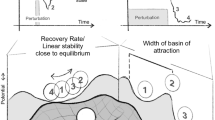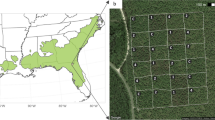Abstract
Ecosystem structure and function are strongly affected by disturbance events, many of which in North America are associated with seasonal temperature extremes, wildfires, and tropical storms. This study was conducted to evaluate patterns in a 19-year record of global satellite observations of vegetation phenology from the advanced very high resolution radiometer (AVHRR) as a means to characterize major ecosystem disturbance events and regimes. The fraction absorbed of photosynthetically active radiation (FPAR) by vegetation canopies worldwide has been computed at a monthly time interval from 1982 to 2000 and gridded at a spatial resolution of 8–km globally. Potential disturbance events were identified in the FPAR time series by locating anomalously low values (FPAR-LO) that lasted longer than 12 consecutive months at any 8-km pixel. We can find verifiable evidence of numerous disturbance types across North America, including major regional patterns of cold and heat waves, forest fires, tropical storms, and large-scale forest logging. Summed over 19 years, areas potentially influenced by major ecosystem disturbances (one FPAR-LO event over the period 1982–2000) total to more than 766,000 km2. The periods of highest detection frequency were 1987–1989, 1995–1997, and 1999. Sub-continental regions of the Pacific Northwest, Alaska, and Central Canada had the highest proportion (>90%) of FPAR-LO pixels detected in forests, tundra shrublands, and wetland areas. The Great Lakes region showed the highest proportion (39%) of FPAR-LO pixels detected in cropland areas, whereas the western United States showed the highest proportion (16%) of FPAR-LO pixels detected in grassland areas. Based on this analysis, an historical picture is emerging of periodic droughts and heat waves, possibly coupled with herbivorous insect outbreaks, as among the most important causes of ecosystem disturbance in North America.









Similar content being viewed by others
References
Amiro BD, Todd JB, Wotton BM, Logan KA, Flannigan MD, Stocks BJ, Mason JA, Martell DL, Hirsch KG. 2001. Direct carbon emissions from Canadian forest fires, 1959–1999. Can J For Res 31: 512–25
Andreae MO. 1991. Biomass burning: its history, use, and distribution and its impact on environmental quality and global climate. In: Levine JS, Eds. Global Biomass Burning: Atmospheric, Climactic and Biospheric Implications, New York: MIT Press. p 3–21
Arino O, Plummer S. 1999. Along track scanning radiometer world fire atlas: validation of the 1997–1998 active fire product. IGBP Report
Barbosa PM, Grégoire J-M, Stroppiana D, Pereira JMC, 1999. An assessment of fire in Africa (1981–1991): Burnt biomass and atmospheric emissions. Global Biogeochemical Cycles, 13:933–950
Bergman KH, Ropelewski CF, Halpert MS. 1986. The record southeast drought of 1986. Weatherwise 39:262–6
Canadell JG, Mooney HA, Baldocchi DD, Berry JA, Ehleringer JR, Field CB, Gower ST, Hollinger DY, Hunt JE, Jackson RB, Running SW, Shaver GR, Steffen W, Trumbore SE, Valentini R, Bond BY. 2000. Carbon metabolism of the terrestrial biosphere: a multi-technique approach for improving understanding. Ecosystems 3:115–30
Canadian Interagency Forest Fire Centre (CIFFC). 2001. Canada Report 2001, Winnipeg, Canada. p 6
Cohen WB, Fiorella M, Gray J, Helmer E, Anderson K. 1998. An efficient and accurate method for mapping forest clearcuts in the Pacific Northwest using Landsat imagery. Photogram Eng Remote Sens 64:293–300
Cohen W, Spies T, Alig R, Oetter D, Maiersperger T, Fiorella M. 2002. Characterizing 23 years (1972–1995) of stand replacement disturbance in western Oregon forests with Landsat imagery. Ecosystems 5:122–137
DeFries R, Townshend J. 1994. NDVI-derived land cover classification at global scales. Internl J Remote Sens 15:3567–86
Environment Canada. 1999. Climate Trends and Variations Bulletin for Canada, Atmospheric Environment Service Downsview, Ontario, p 2
Fearnside PM. 1997. Greenhouse gases from deforestation in Brazilian Amazonia: net committed emissions. Clim Change 35:321–60
Friedl MA, McIver DK, Hodges JCF, Zhang XY, Muchoney D, Strahler AH, Woodcock CE, Gopal S, Schneider A, Cooper A, Baccini A, Gao F, Schaaf C. 2002. Global land cover mapping from MODIS: algorithms and early results. Remote Sens Environ 83:287–302
Galindo I, Lopez Perez P, Evangelista Salazar M. 2003. Real-time AVHRR forest fire detection in Mexico (1998–2000). Int J Remote Sens 24:9–22
Heinselman ML. 1973. Fire in the virgin forests of the Boundary Waters Canoe Area, Minnesota. Quaternary Res 3:329–382
Hicke JA, Asner GP, Randerson JT, Tucker CJ, Los SO, Birdsey R, Jenkins JC, Field CB, Holland EA. 2002. Satellite-derived increases in net primary productivity across North America, 1982–1998. Geophys Res Lett 29(10):1427, doi:10.1029/2001GL013578
Houghton RA, Hackler JL, Lawrence KT. 1999. The U.S. carbon budget: contributions from land-use change. Science 285:574–9
Houghton RA. 1999. The annual net flux of carbon to the atmosphere from changes in land use 1850–1990. Tellus 51B:298–313
Houghton RA, Lawrence KT, Hackler JL, Brown S. 2001. The spatial distribution of forest biomass in the Brazilian Amazon. Glob Change Biol 7:731–46
Houghton RA, Hackler JL. 1999. Emissions of carbon from forestry and land-use change in tropical Asia. Global Change Biol. 5:481–92
Hurst DF, Griffith DWT, Cook GD. 1994. Trace gas emissions from biomass burning in tropical Australian savannas. J Geophys Res 99:16441–56
Jeffrey D. 1989. Yellowstone: the great fires of 1988. Natl Geogr 175:255–73
Karl TR, Young PJ. 1987. The 1986 Southeast drought in historical perspective. Bull Am Meteorol Soc 68:773–8
Kasischke ES, French NHF, Bourgeau-Chavez LL. 1999. Using satellite data to monitor fire-related processes in boreal forests. In: Kasischke ES, Stocks BJ, Eds. Fire, Climate Change and Carbon Cycling in the Boreal Forest, Ecological Studies Series. Berlin, Heiedlberg, New York: Springer, p 406–22
Kistler R, Kalnay E, Collins W, Saha S, White G, Woollen J, Chelliah M, Ebisuzaki W, Kanamitsu M, Kousky V, van den Dool H, Jenne R, Fiorino M. 2001. The NCEP-NCAR 50–year reanalysis. Bull Amer Meteorol Soc 82:247–68
Knyazikhin Y, Martonchik JV, Myneni RB, Diner DJ, Running SW. 1998. Synergistic algorithm for estimating vegetation canopy leaf area index and fraction of absorbed photosynthetically active radiation from MODIS and MISR data. J Geophys Res 103:32257–76
Kucharik CJ. 2003. Evaluation of a process-based agro-ecosystem model (Agro-IBIS) across the U.S. cornbelt: simulations of the inter-annual variability in maize yield. Earth Interact 7:1–33
Kurz WA, Apps MJ. 1999. A 70–years retrospective analysis of carbon fluxes in the Canadian forest sector. Ecol Appl 9:526–47
Landsea C. 1993. A climatology of intense (or major) Atlantic hurricanes. Mon Weather Rev 121:1703–13
Logan JA, Powell JA. 2001. Ghost forests, global warming, and the mountain pine beetle. Am Entomol 47:160–73
Murph PJ, Mudd JP, Stocks BJ, Kasischke ES, Barry D, Alexander ME, French NHF. 2000. Chapter 15: historical fire records in the North American boreal forest. In: Kasischke ES, Stocks BJ, Eds. Fire, Climate Change, and Carbon Cycling in the Boreal Forests. Berlin Heidelberg New York: Springer
Myneni RB, Tucker CJ, Asrar G, Keeling CD. 1998. Interannual variations in satellite-sensed vegetation index data from 1981 to 1991. J Geophys Res 103:6145–60
NRC (National Research Council). 2000. Environmental Issues in Pacific Northwest Forest Management. Washington (DC): National Academy Press
Nepstad DC, Veríssimo A, Alencar A, Nobre C, Lima E, Lefebvre P, Schlesinger P, Potter C, Moutinho P, Mendoza E, Cochrane M, Brooks V. 1999. Large-scale impoverishment of Amazonian forests by logging and fire. Nature 398:505–8
New M, Hulme M, Jones P. 2000. Representing twentieth century space-time climate variability. II. Development of 1901–1996 monthly grids of terrestrial surface climate. J Clim 13:2217–38
Pickett STA, White PS. 1985. The Ecology of Natural Disturbance as Patch Dynamics. New York: Academic Press
Potter CS. 1999. Terrestrial biomass and the effects of deforestation on the global carbon cycle. BioScience 49:769–78
Potter CS, Klooster SA, Brooks V. 1999. Interannual variability in terrestrial net primary production: exploration of trends and controls on regional to global scales. Ecosystems 2:36–48
Potter CS, Brooks-Genovese V, Klooster SA, Bobo M, Torregrosa A. 2001. Biomass burning losses of carbon estimated from ecosystem modeling and satellite data analysis for the Brazilian Amazon region. Atmos Environ 35:1773–81
Potter C, Tan P, Steinbach M, Klooster S, Kumar V, Myneni R, Genovese V. 2003a. Major disturbance events in terrestrial ecosystems detected using global satellite data sets. Glob Change Biol 9(7): 1005–21
Potter C, Klooster S, Myneni R, Genovese V, Tan P, Kumar V. 2003b. Continental scale comparisons of terrestrial carbon sinks estimated from satellite data and ecosystem modeling 1982–1998. Glob Planet Change 39:201–13
Powell MD, Aberson SD. 2001. Accuracy of United States tropical cyclone landfall forecasts in the Atlantic basin 1976–2000. Bull Am Meteoro Soc. 82:2749–67
Renkin RA, Despain DG. 1992. Fuel moisture, forest type, and lightning-caused fires in Yellowstone National Park. Can Forestry Forest Res 22:37–45
Schimel D, House J, Hibbard K, Bousquet P, Ciais P, Peylin P, Apps M, Baker D, Bondeau A, Brasswell R, Canadell J, Churkina G, Cramer W, Denning S, Field C, Friedlingstein P, Goodale C, Heimann M, Houghton RA, Melillo J, Moore III B, Murdiyarso D, Noble I, Pacala S, Prentice C, Raupach M, Rayner P, Scholes B, Steffen W, Wirth C. 2001. Recent patterns and mechanisms of carbon exchange by terrestrial ecosystems, Nature 414:169–72
Scholes RJ, Kendall J, Justice CO. 1996. The quantity of biomass burned in southern Africa. J Geophy Res 101:23667–23676
Stockburger DW. 1998. Introductory Statistics: Concepts, Models, And Applications, WWW Version 1.0, http://www.psychstat.smsu.edu/sbk00.htm
Tilman D. 1985. The resource-ratio hypothesis of plant succession. Am Nat 125:827–852
Walker LR, Willig MR, eds. 1999. Ecology of Disturbed Ground. Amsterdam: Elsevier
Weatherspoon CP, Skinner CN. 1995. An assessment of factors associated with damage to tree crowns from 1987 wildfires in northern California. Forest Sci 41:430–51.
Acknowledgements
This work was supported by grants from NASA programs in Intelligent Systems and Intelligent Data Understanding, and the NASA Earth Observing System (EOS) Interdisciplinary Science Program. Landsat-based maps for historical forest disturbance in Oregon and Washington are attributed to the Interagency Regional Monitoring Program.
Author information
Authors and Affiliations
Corresponding author
Rights and permissions
About this article
Cite this article
Potter, C., Tan, PN., Kumar, V. et al. Recent History of Large-Scale Ecosystem Disturbances in North America Derived from the AVHRR Satellite Record. Ecosystems 8, 808–824 (2005). https://doi.org/10.1007/s10021-005-0041-6
Received:
Accepted:
Published:
Issue Date:
DOI: https://doi.org/10.1007/s10021-005-0041-6




